Smoking-Induced DNA Hydroxymethylation Signature Is Less Pronounced than True DNA Methylation: The Population-Based KORA Fit Cohort
Abstract
:1. Introduction
2. Materials and Methods
2.1. Study Population
2.2. DNA Extraction and DNA Methylation Quantification
2.3. Preprocessing and Normalization
2.4. Differential Methylation Analysis
2.5. Gene Enrichment Analyses
3. Results
3.1. Characteristics of the Study Population
3.2. Distribution of Methylation β-Values
3.3. Site-Specific Changes in Total 5mC+5hmC Associated with Smoking
3.4. Site-Specific True Methylation Changes Associated with Smoking
3.5. Site-Specific Hydroxymethylation Changes Associated with Smoking
3.6. Region-Specific Changes Associated with Smoking
3.7. Gene Enrichment Analysis
4. Discussion
5. Conclusions
Supplementary Materials
Author Contributions
Funding
Institutional Review Board Statement
Informed Consent Statement
Data Availability Statement
Acknowledgments
Conflicts of Interest
References
- Wei, X.; Guo, K.; Shang, X.; Wang, S.; Yang, C.; Li, J.; Li, Y.; Yang, K.; Li, X.; Zhang, X. Effects of different interventions on smoking cessation in chronic obstructive pulmonary disease patients: A systematic review and network meta-analysis. Int. J. Nurs. Stud. 2022, 136, 104362. [Google Scholar] [CrossRef]
- Kondo, T.; Nakano, Y.; Adachi, S.; Murohara, T. Effects of tobacco smoking on cardiovascular disease. Circ. J. 2019, 83, 1980–1985. [Google Scholar] [CrossRef]
- Thomson, N.C.; Polosa, R.; Sin, D.D. Cigarette smoking and asthma. J. Allergy Clin. Immunol. Pract. 2022, 10, 2783–2797. [Google Scholar] [CrossRef]
- Domingo-Relloso, A.; Joehanes, R.; Rodriguez-Hernandez, Z.; Lahousse, L.; Haack, K.; Fallin, M.D.; Herreros-Martinez, M.; Umans, J.G.; Best, L.G.; Huan, T.; et al. Smoking, blood DNA methylation sites and lung cancer risk. Environ. Pollut. 2023, 334, 122153. [Google Scholar] [CrossRef]
- Skvortsova, K.; Stirzaker, C.; Taberlay, P. The DNA methylation landscape in cancer. Essays Biochem. 2019, 63, 797–811. [Google Scholar] [CrossRef]
- Gallus, S.; Scala, M.; Possenti, I.; Jarach, C.M.; Clancy, L.; Fernandez, E.; Gorini, G.; Carreras, G.; Malevolti, M.C.; Commar, A.; et al. The role of smoking in COVID-19 progression: A comprehensive meta-analysis. Eur. Respir. Rev. 2023, 32, 220191. [Google Scholar] [CrossRef]
- Seo, Y.S.; Park, J.M.; Kim, J.H.; Lee, M.Y. Cigarette smoke-induced reactive oxygen species formation: A concise review. Antioxidants 2023, 12, 1732. [Google Scholar] [CrossRef]
- Caliri, A.W.; Tommasi, S.; Besaratinia, A. Relationships among smoking, oxidative stress, inflammation, macromolecular damage, and cancer. Mutat. Res. Rev. Mutat. Res. 2021, 787, 108365. [Google Scholar] [CrossRef]
- Heikkinen, A.; Bollepalli, S.; Ollikainen, M. The potential of DNA methylation as a biomarker for obesity and smoking. J. Intern. Med. 2022, 292, 390–408. [Google Scholar] [CrossRef]
- Joehanes, R.; Just, A.C.; Marioni, R.E.; Pilling, L.C.; Reynolds, L.M.; Mandaviya, P.R.; Guan, W.; Xu, T.; Elks, C.E.; Aslibekyan, S.; et al. Epigenetic signatures of cigarette smoking. Circ. Cardiovasc. Genet. 2016, 9, 436–447. [Google Scholar] [CrossRef]
- Ambatipudi, S.; Cuenin, C.; Hernandez-Vargas, H.; Ghantous, A.; Le Calvez-Kelm, F.; Kaaks, R.; Barrdahl, M.; Boeing, H.; Aleksandrova, K.; Trichopoulou, A.; et al. Tobacco smoking-associated genome-wide DNA methylation changes in the EPIC study. Epigenomics 2016, 8, 599–618. [Google Scholar] [CrossRef]
- Higashi, Y. Smoking cessation and vascular endothelial function. Hypertens. Res. 2023, 46, 2670–2678. [Google Scholar] [CrossRef]
- Fragou, D.; Pakkidi, E.; Aschner, M.; Samanidou, V.; Kovatsi, L. Smoking and DNA methylation: Correlation of methylation with smoking behavior and association with diseases and fetus development following prenatal exposure. Food Chem. Toxicol. 2019, 129, 312–327. [Google Scholar] [CrossRef]
- Yano, N.; Fedulov, A.V. Targeted DNA demethylation: Vectors, effectors and perspectives. Biomedicines 2023, 11, 1334. [Google Scholar] [CrossRef]
- Prasad, R.; Yen, T.J.; Bellacosa, A. Active DNA demethylation-The epigenetic gatekeeper of development, immunity, and cancer. Adv. Genet. 2021, 2, e10033. [Google Scholar] [CrossRef]
- Klungland, A.; Robertson, A.B. Oxidized C5-methyl cytosine bases in DNA: 5-Hydroxymethylcytosine; 5-formylcytosine; and 5-carboxycytosine. Free Radic. Biol. Med. 2017, 107, 62–68. [Google Scholar] [CrossRef]
- Xu, T.; Gao, H. Hydroxymethylation and tumors: Can 5-hydroxymethylation be used as a marker for tumor diagnosis and treatment? Hum. Genom. 2020, 14, 15. [Google Scholar] [CrossRef]
- Kranzhöfer, D.K.; Gilsbach, R.; Grüning, B.A.; Backofen, R.; Nührenberg, T.G.; Hein, L. 5′-Hydroxymethylcytosine precedes loss of CpGmethylation in enhancers and genes undergoing activation in cardiomyocyte maturation. PLoS ONE 2016, 11, e0166575. [Google Scholar] [CrossRef]
- Zhou, X.; Zhuang, Z.; Wang, W.; He, L.; Wu, H.; Cao, Y.; Pan, F.; Zhao, J.; Hu, Z.; Sekhar, C.; et al. OGG1 is essential in oxidative stress induced DNA demethylation. Cell. Signal. 2016, 28, 1163–1171. [Google Scholar] [CrossRef]
- Lu, M.J.; Lu, Y. 5-Hydroxymethylcytosine (5hmC) at or near cancer mutation hot spots as potential targets for early cancer detection. BMC Res. Notes 2022, 15, 143. [Google Scholar] [CrossRef]
- Wang, Z.; Du, M.; Yuan, Q.; Guo, Y.; Hutchinson, J.N.; Su, L.; Zheng, Y.; Wang, J.; Mucci, L.A.; Lin, X.; et al. Epigenomic analysis of 5-hydroxymethylcytosine (5hmC) reveals novel DNA methylation markers for lung cancers. Neoplasia 2020, 22, 154–161. [Google Scholar] [CrossRef]
- Nestor, C.; Ruzov, A.; Meehan, R.; Dunican, D. Enzymatic approaches and bisulfite sequencing cannot distinguish between 5-methylcytosine and 5-hydroxymethylcytosine in DNA. Biotechniques 2010, 48, 317–319. [Google Scholar] [CrossRef]
- Holle, R.; Happich, M.; Löwel, H.; Wichmann, H.E. KORA—A research platform for population based health research. Gesundheitswesen 2005, 67 (Suppl. S1), S19–S25. [Google Scholar] [CrossRef]
- Booth, M.J.; Ost, T.W.; Beraldi, D.; Bell, N.M.; Branco, M.R.; Reik, W.; Balasubramanian, S. Oxidative bisulfite sequencing of 5-methylcytosine and 5-hydroxymethylcytosine. Nat. Protoc. 2013, 8, 1841–1851. [Google Scholar] [CrossRef]
- De Borre, M.; Branco, M.R. Oxidative bisulfite sequencing: An experimental and computational protocol. Methods Mol. Biol. 2021, 2198, 333–348. [Google Scholar] [CrossRef]
- Hattori, N.; Liu, Y.Y.; Ushijima, T. DNA methylation analysis. Methods Mol. Biol. 2023, 2691, 165–183. [Google Scholar] [CrossRef]
- Bock, C. Analysing and interpreting DNA methylation data. Nat. Rev. Genet. 2012, 13, 705–719. [Google Scholar] [CrossRef]
- Houseman, E.A.; Accomando, W.P.; Koestler, D.C.; Christensen, B.C.; Marsit, C.J.; Nelson, H.H.; Wiencke, J.K.; Kelsey, K.T. DNA methylation arrays as surrogate measures of cell mixture distribution. BMC Bioinform. 2012, 13, 86. [Google Scholar] [CrossRef]
- Battram, T.; Yousefi, P.; Crawford, G.; Prince, C.; Babaei, M.S.; Sharp, G.; Hatcher, C.; Vega-Salas, M.J.; Khodabakhsh, S.; Whitehurst, O.; et al. The EWAS Catalog: A database of epigenome-wide association studies. Wellcome Open Res. 2022, 7, 41. [Google Scholar] [CrossRef]
- Christiansen, C.; Castillo-Fernandez, J.E.; Domingo-Relloso, A.; Zhao, W.; El-Sayed Moustafa, J.S.; Tsai, P.C.; Maddock, J.; Haack, K.; Cole, S.A.; Kardia, S.L.R.; et al. Novel DNA methylation signatures of tobacco smoking with trans-ethnic effects. Clin. Epigenetics 2021, 13, 36. [Google Scholar] [CrossRef]
- Silva, C.P.; Kamens, H.M. Cigarette smoke-induced alterations in blood: A review of research on DNA methylation and gene expression. Exp. Clin. Psychopharmacol. 2021, 29, 116–135. [Google Scholar] [CrossRef]
- Nomura, S.; Morita, H. Dysregulation of DNA methylation in the aryl-hydrocarbon receptor repressor (AHRR) gene. Circ. J. 2022, 86, 993–994. [Google Scholar] [CrossRef]
- Langsted, A.; Bojesen, S.E.; Stroes, E.S.G.; Nordestgaard, B.G. AHRR hypomethylation as an epigenetic marker of smoking history predicts risk of myocardial infarction in former smokers. Atherosclerosis 2020, 312, 8–15. [Google Scholar] [CrossRef]
- Wilson, R.; Wahl, S.; Pfeiffer, L.; Ward-Caviness, C.K.; Kunze, S.; Kretschmer, A.; Reischl, E.; Peters, A.; Gieger, C.; Waldenberger, M. The dynamics of smoking-related disturbed methylation: A two time-point study of methylation change in smokers, non-smokers and former smokers. BMC Genom. 2017, 18, 805. [Google Scholar] [CrossRef]
- Morrow, J.D.; Make, B.; Regan, E.; Han, M.; Hersh, C.P.; Tal-Singer, R.; Quackenbush, J.; Choi, A.M.K.; Silverman, E.K.; DeMeo, D.L. DNA methylation is predictive of mortality in current and former smokers. Am. J. Respir. Crit. Care Med. 2020, 201, 1099–1109. [Google Scholar] [CrossRef]
- Langdon, R.J.; Yousefi, P.; Relton, C.L.; Suderman, M.J. Epigenetic modelling of former, current and never smokers. Clin. Epigenetics 2021, 13, 206. [Google Scholar] [CrossRef]
- Yan, Q.; Forno, E.; Celedón, J.C.; Chen, W. A region-based method for causal mediation analysis of DNA methylation data. Epigenetics 2022, 17, 286–296. [Google Scholar] [CrossRef]
- Howe, C.G.; Cox, B.; Fore, R.; Jungius, J.; Kvist, T.; Lent, S.; Miles, H.E.; Salas, L.A.; Rifas-Shiman, S.; Starling, A.P.; et al. Maternal gestational diabetes mellitus and newborn DNA methylation: Findings from the pregnancy and childhood epigenetics consortium. Diabetes Care 2020, 43, 98–105. [Google Scholar] [CrossRef]
- Zeng, Y.; Chen, T. DNA methylation reprogramming during mammalian development. Genes 2019, 10, 257. [Google Scholar] [CrossRef]
- Robert, F.H.; Daniel, L.M.; Elena, B.; Danni, A.G.; Yi-Peng, C.; Aleksandra, D.C.; Hannah, M.S.; Lee, M.; Nicola, W.; Archie, C.; et al. Blood-based epigenome-wide analyses on the prevalence and incidence of nineteen common disease states. medRxiv 2023. [Google Scholar] [CrossRef]
- Szyf, M. The elusive role of 5′-hydroxymethylcytosine. Epigenomics 2016, 8, 1539–1551. [Google Scholar] [CrossRef]
- Taylor, S.E.; Li, Y.H.; Smeriglio, P.; Rath, M.; Wong, W.H.; Bhutani, N. Stable 5-hydroxymethylcytosine (5hmC) acquisition marks gene activation during chondrogenic differentiation. J. Bone Miner. Res. 2016, 31, 524–534. [Google Scholar] [CrossRef]
- Zhang, Z.; Lee, M.K.; Perreard, L.; Kelsey, K.T.; Christensen, B.C.; Salas, L.A. Navigating the hydroxymethylome: Experimental biases and quality control tools for the tandem bisulfite and oxidative bisulfite Illumina microarrays. Epigenomics 2022, 14, 139–152. [Google Scholar] [CrossRef]
- Shi, D.Q.; Ali, I.; Tang, J.; Yang, W.C. New Insights into 5hmC DNA modification: Generation, distribution and function. Front. Genet. 2017, 8, 100. [Google Scholar] [CrossRef]
- Ringh, M.V.; Hagemann-Jensen, M.; Needhamsen, M.; Kular, L.; Breeze, C.E.; Sjöholm, L.K.; Slavec, L.; Kullberg, S.; Wahlström, J.; Grunewald, J.; et al. Tobacco smoking induces changes in true DNA methylation, hydroxymethylation and gene expression in bronchoalveolar lavage cells. eBioMedicine 2019, 46, 290–304. [Google Scholar] [CrossRef]
- Mitra, D.; Vega-Rubin-de-Celis, S.; Royla, N.; Bernhardt, S.; Wilhelm, H.; Tarade, N.; Poschet, G.; Buettner, M.; Binenbaum, I.; Borgoni, S.; et al. Abrogating GPT2 in triple-negative breast cancer inhibits tumor growth and promotes autophagy. Int. J. Cancer 2021, 148, 1993–2009. [Google Scholar] [CrossRef]
- Yan, F.; Zhang, L.; Duan, L.; Li, L.; Liu, X.; Liu, Y.; Qiao, T.; Zeng, Y.; Fang, H.; Wu, D.; et al. Roles of glutamic pyruvate transaminase 2 in reprogramming of airway epithelial lipidomic and metabolomic profiles after smoking. Clin. Transl. Med. 2024, 14, e1679. [Google Scholar] [CrossRef]
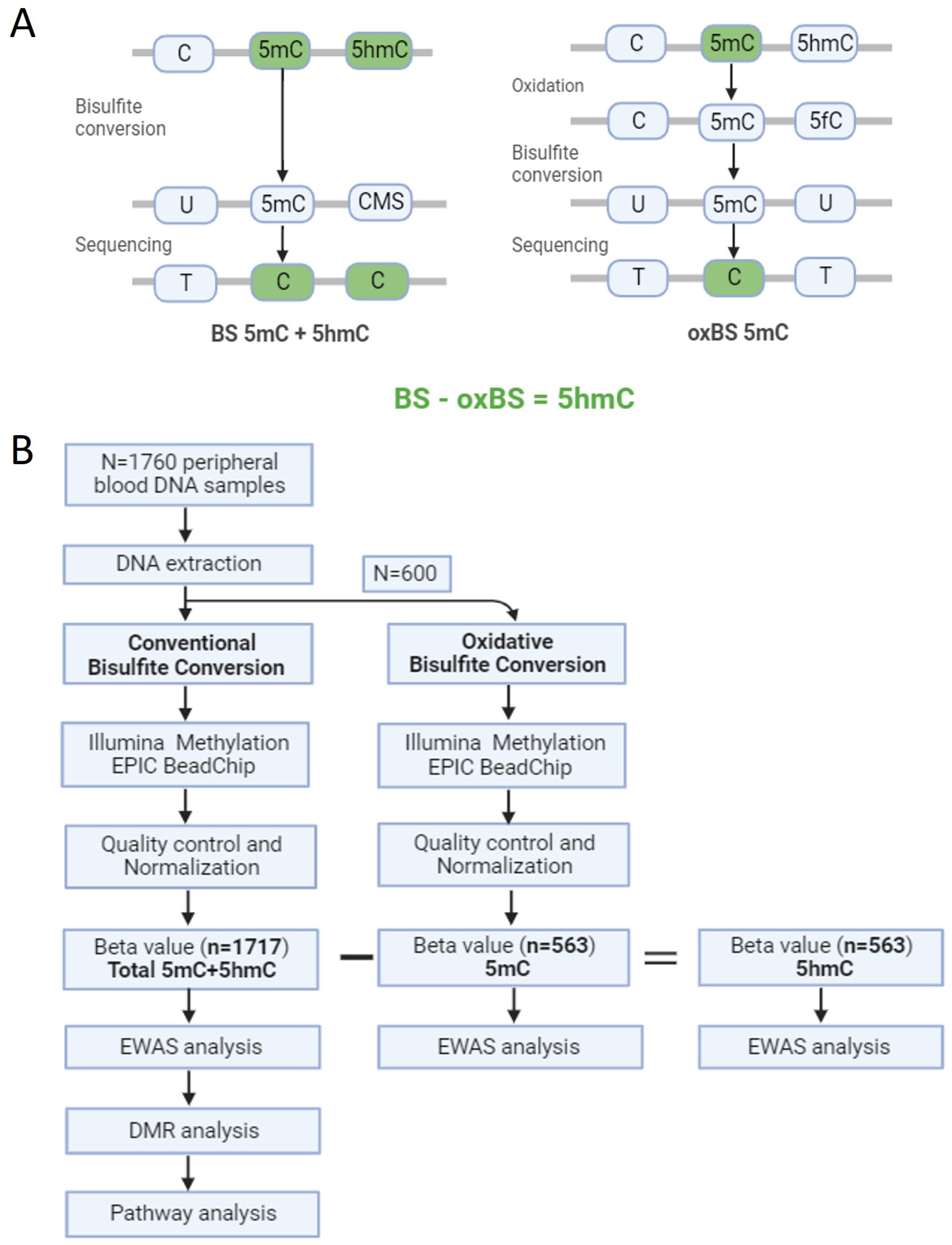
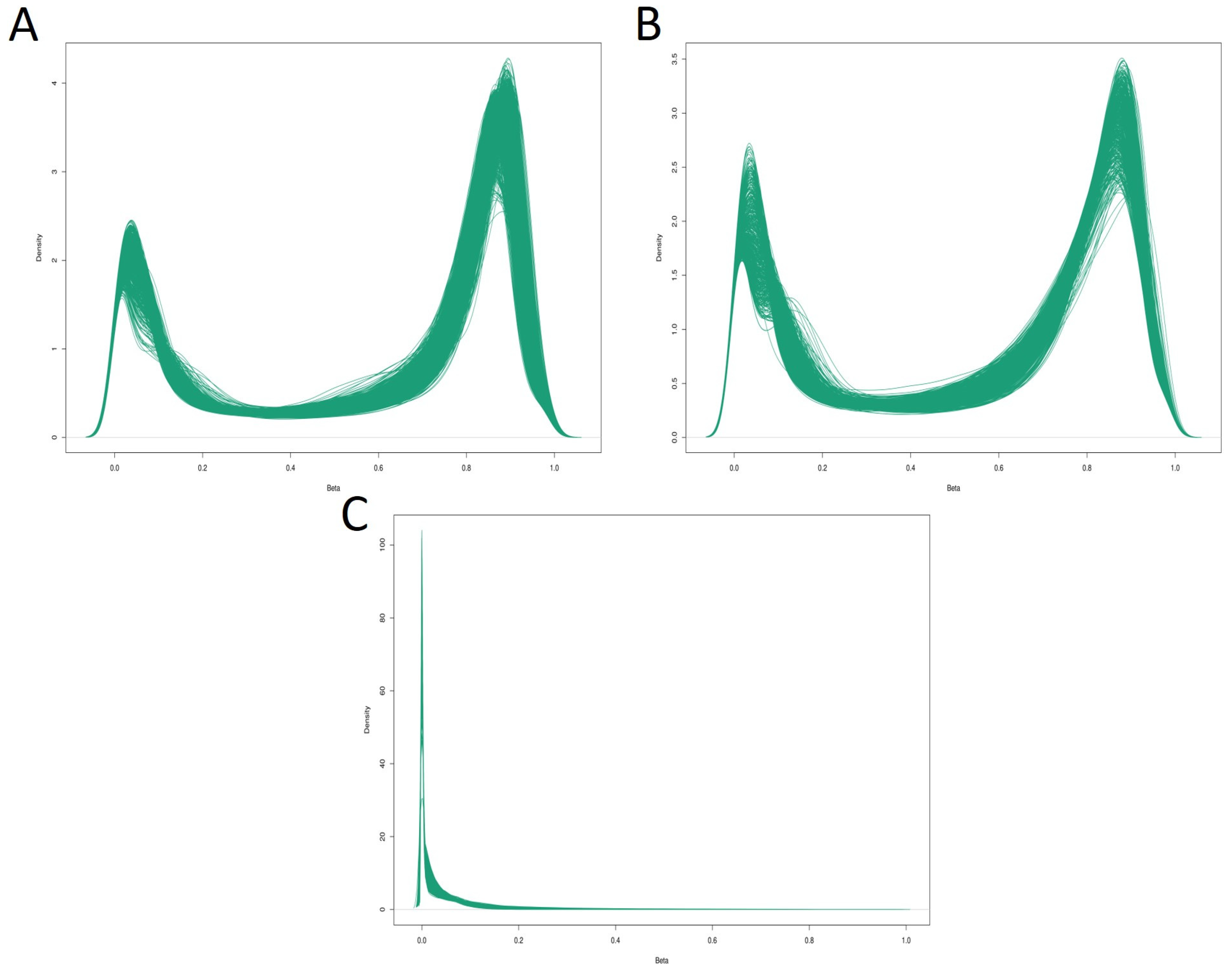
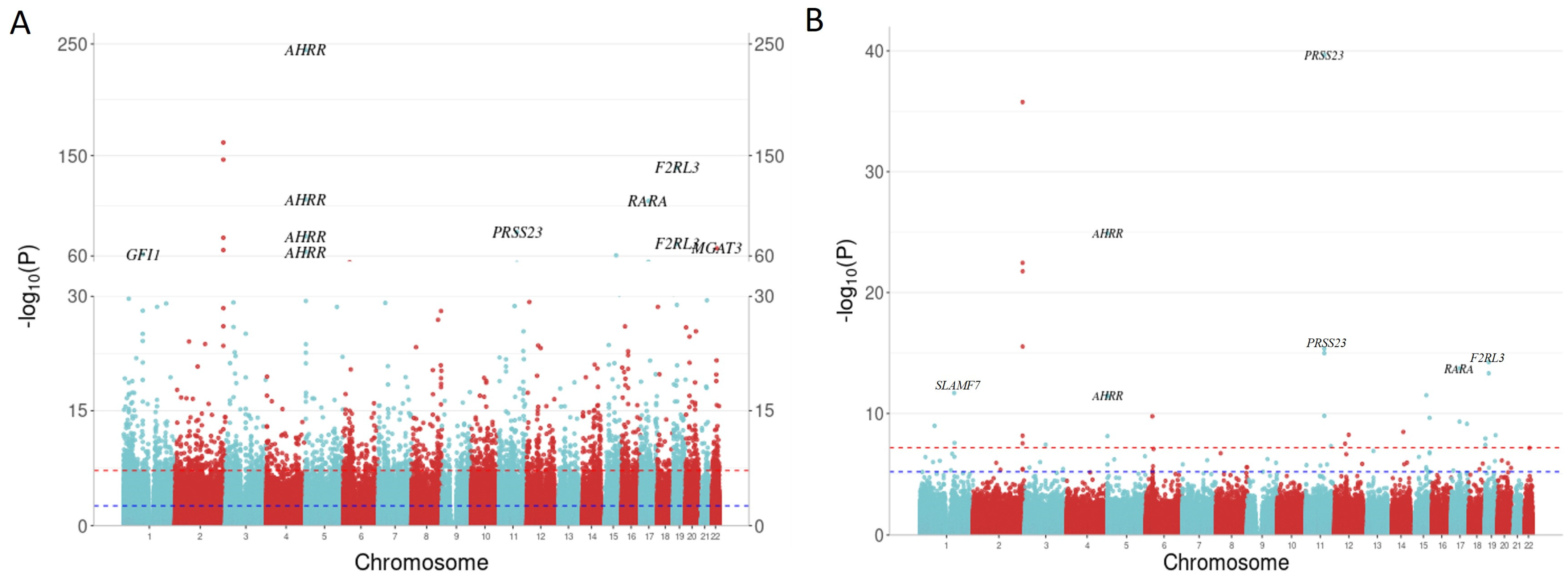
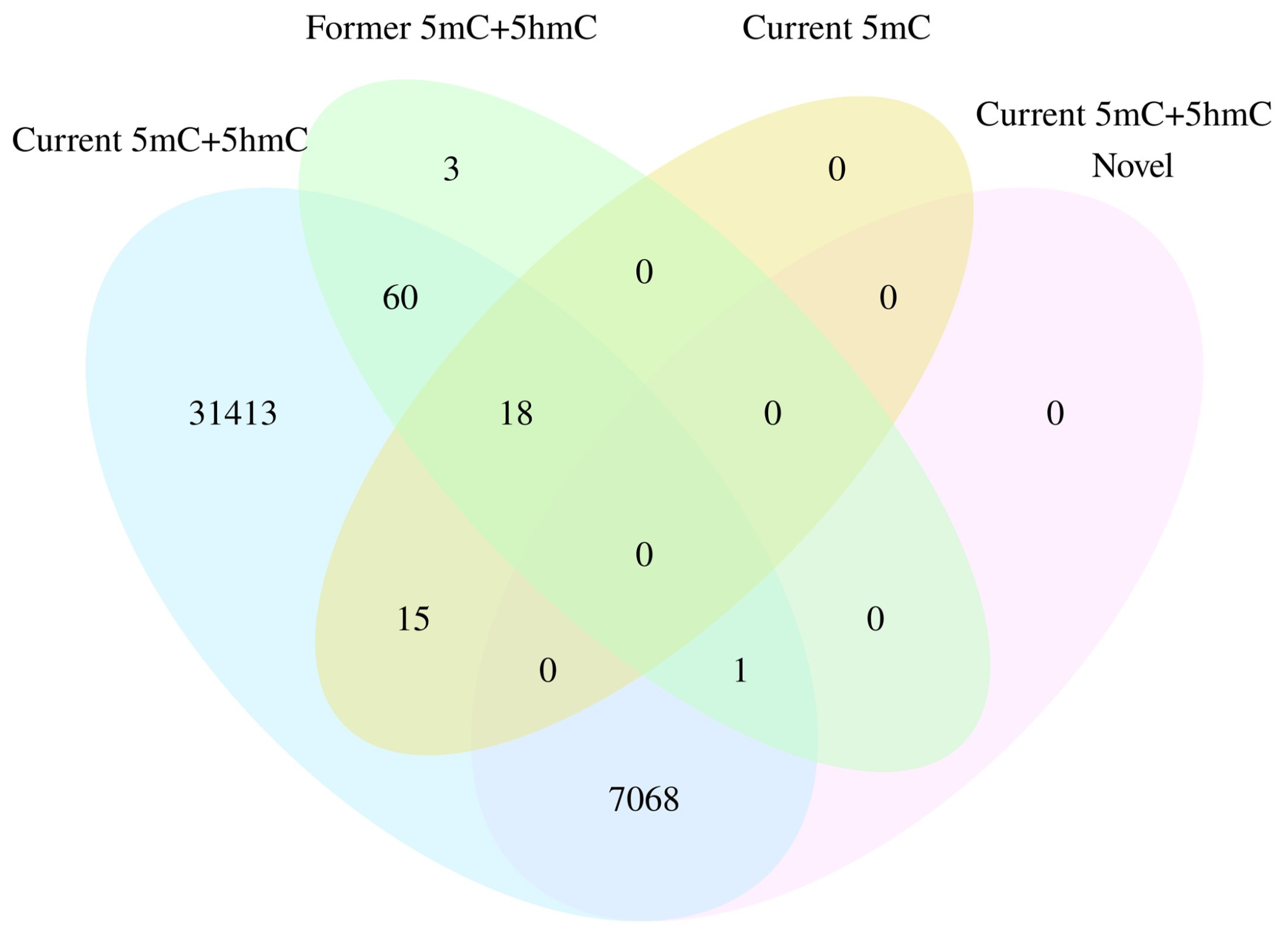
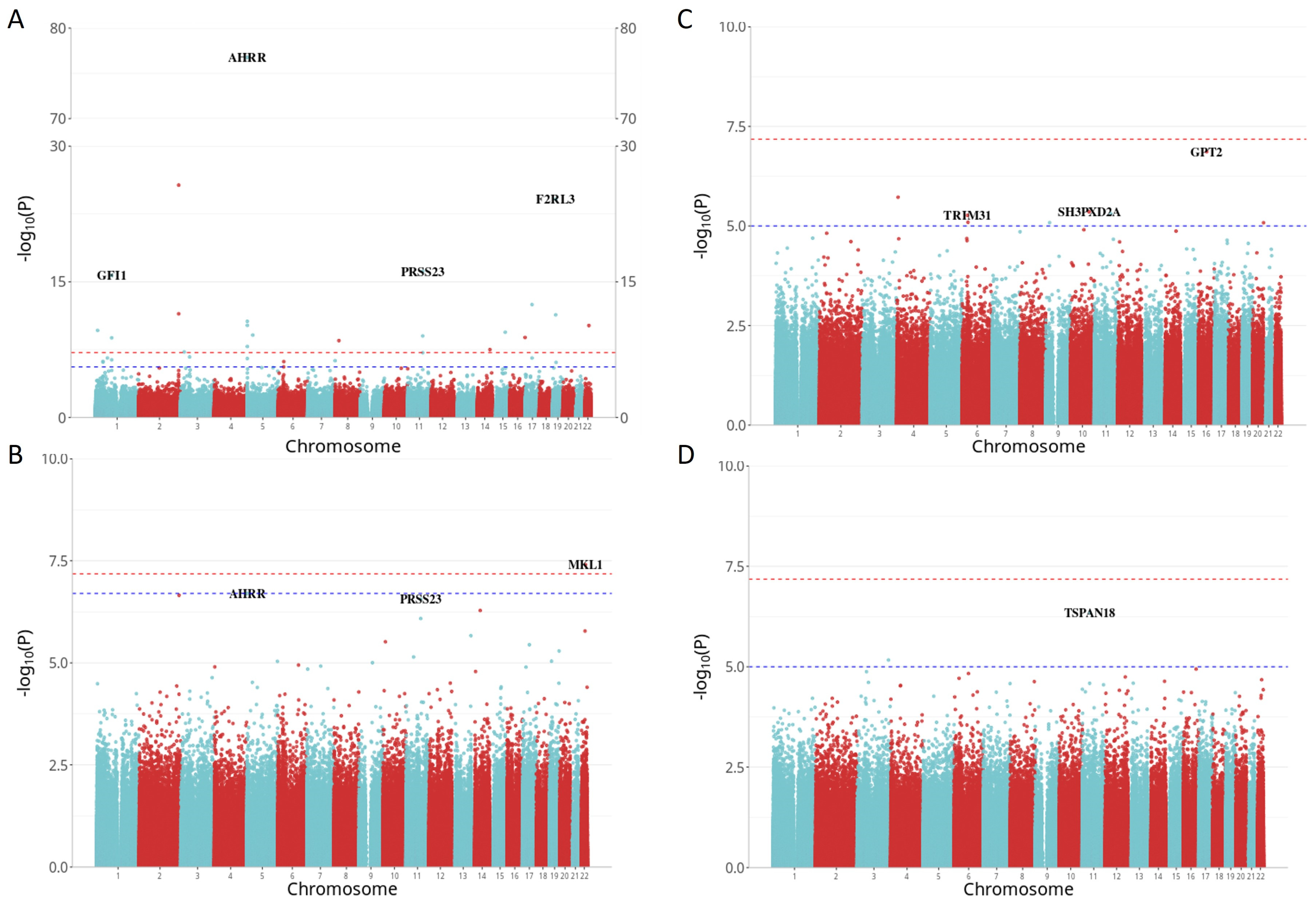
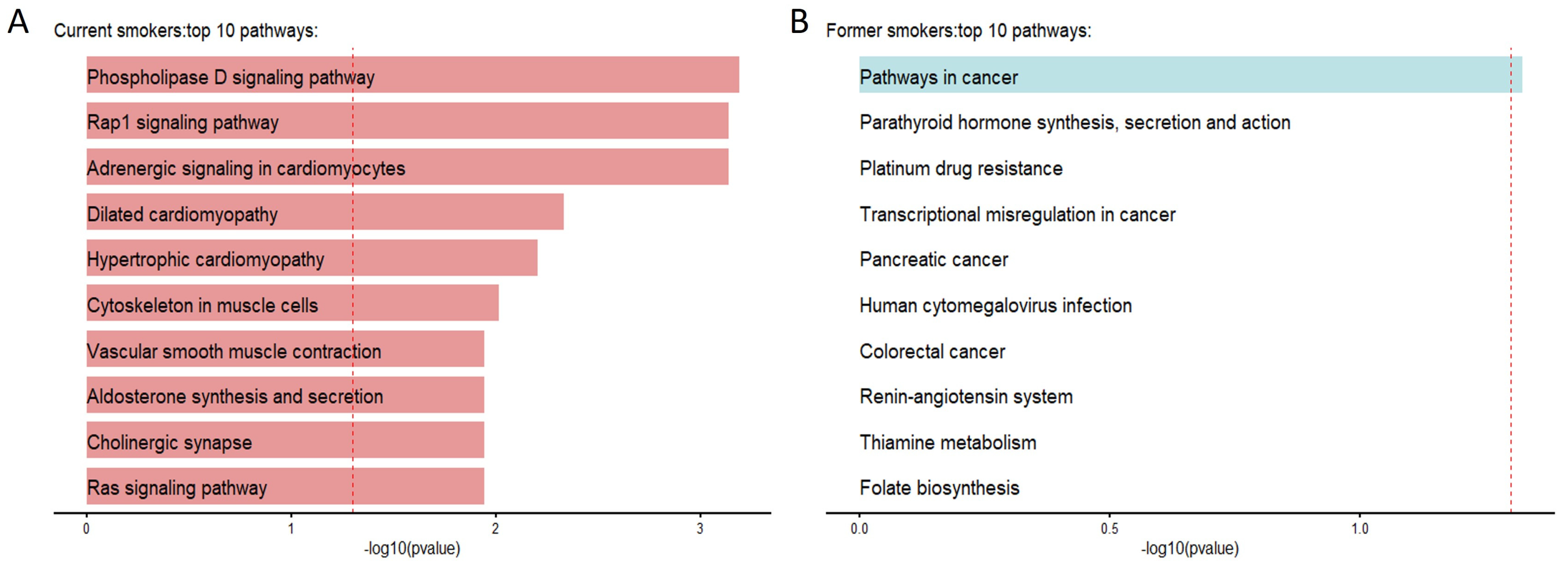
| Characteristics | All Participants | Current Smokers | Former Smokers | Non-Smokers |
|---|---|---|---|---|
| 1717 | 217 | 719 | 781 | |
| Age (years) | 63 (59, 68) | 61 (57, 65) *** | 64 (59, 68) | 63 (59, 68) |
| Male (%) | 814 (46.3%) | 105 (47.3%) | 393 (53.5%) ### | 316 (39.4%) |
| BMI (kg/m2) | 27.4 (24.5, 30.8) | 26.2 (23.7, 30) | 27.6 (24.8, 31.3) # | 27.3 (24.5, 30.3) |
| Physical activity | 1268 (72.1%) | 159 (71.6%) | 535 (72.8%) | 574 (71.6%) |
| Alcohol intake (g/day) | 6.6 (0, 22.9) | 8.6 (0, 30) * | 8.6 (0.2, 23.8) ## | 5.7 (0, 20) |
| Hypertension | 855 (48.7%) | 82 (36.9%) * | 395 (53.8%) # | 378 (47.2%) |
| Diabetes mellitus | 135 (7.7%) | 14 (6.3%) | 65 (8.9%) | 56 (7%) |
| HDL-cholesterol (mg/dL) | 61.7 (51.1, 75) | 58.5 (49, 69.9) *** | 61.2 (50, 75) # | 62.8 (53, 77.2) |
| LDL-cholesterol (mg/dL) | 122.8 (99.1, 146.5) | 124.7 (99.9, 147.4) | 119.6 (95.6, 144) ## | 126.2 (103, 147.8) |
| Total cholesterol (mg/dL) | 212.4 (185.1, 238.3) | 211.9 (184.4, 234.7) | 208.9 (181.8, 236.1) ## | 215.8 (189.6, 241.9) |
| Triglycerides (mg/dL) | 106 (77.7, 145.6) | 109.3 (85.4, 153.5) * | 107.7 (77.9, 149.2) # | 103 (76.2, 139) |
| Fasting glucose (mg/dL) | 98 (92, 107) | 96 (91, 104) | 100 (93, 109) ### | 97 (92, 105) |
| HOMA-IR | 2.3 (1.5, 3.5) | 2.1 (1.4, 3) | 2.3 (1.5, 3.6) | 2.3 (1.5, 3.4) |
| HOMA-Beta | 97.8 (71.2, 132) | 93.1 (68.7, 124.2) | 97.1 (68.9, 132.3) | 101 (73.9, 132.7) |
| HbA1c (%) | 5.5 (5.3, 5.8) | 5.6 (5.3, 5.8) * | 5.5 (5.3, 5.8) | 5.5 (5.2, 5.8) |
| Probe | Delta Beta | p Value | FDR | CHR | Gene | MAPINFO | EPIC |
|---|---|---|---|---|---|---|---|
| Current DMPs | data | data | |||||
| cg05575921 | −22.72% | 2.13 × 10−245 | 1.56 × 10−239 | 5 | AHRR | 373378 | |
| cg21566642 | −16.26% | 1.89 × 10−162 | 6.94 × 10−157 | 2 | 233284661 | ||
| cg01940273 | −9.67% | 5.22 × 10−147 | 1.27 × 10−141 | 2 | 233284934 | ||
| cg03636183 | −9.88% | 5.45 × 10−140 | 1.00 × 10−134 | 19 | F2RL3 | 17000585 | |
| cg21161138 | −6.88% | 1.91 × 10−111 | 2.80 × 10−106 | 5 | AHRR | 399360 | |
| cg17739917 | −10.21% | 4.62 × 10−110 | 5.65 × 10−105 | 17 | RARA | 38477572 | * |
| cg14391737 | −10.12% | 5.50 × 10−82 | 5.77 × 10−77 | 11 | PRSS23 | 86513429 | * |
| cg26703534 | −4.88% | 1.90 × 10−78 | 1.75 × 10−73 | 5 | AHRR | 377358 | |
| cg17087741 | −6.13% | 4.22 × 10−77 | 3.44 × 10−72 | 2 | 233283010 | ||
| cg21911711 | −5.65% | 1.44 × 10−71 | 1.06 × 10−66 | 19 | F2RL3 | 16998668 | * |
| Former DMPs | |||||||
| cg14391737 | −4.56% | 2.23 × 10−40 | 1.63 × 10−34 | 11 | PRSS23 | 86513429 | * |
| cg21566642 | −4.62% | 1.74 × 10−36 | 6.40 × 10−31 | 2 | 233284661 | ||
| cg05575921 | −4.06% | 1.20 × 10−25 | 2.95 × 10−20 | 5 | AHRR | 373378 | |
| cg06644428 | −2.20% | 3.45 × 10−23 | 6.34 × 10−18 | 2 | 233284112 | ||
| cg01940273 | −2.24% | 1.74 × 10−22 | 2.56 × 10−17 | 2 | 233284934 | ||
| cg16841366 | −2.62% | 2.90 × 10−16 | 3.56 × 10−11 | 2 | 233286192 | * | |
| cg11660018 | −1.65% | 4.39 × 10−16 | 4.61 × 10−11 | 11 | PRSS23 | 86510915 | |
| cg00475490 | −1.53% | 1.04 × 10−15 | 9.56 × 10−11 | 11 | PRSS23 | 86517110 | * |
| cg03636183 | −1.88% | 5.66 × 10−15 | 1.35 × 10−9 | 19 | F2RL3 | 17000585 | |
| cg17739917 | −2.20% | 1.85 × 10−14 | 1.35 × 10−9 | 17 | RARA | 38477572 | * |
| cg14391737 | −4.56% | 2.23 × 10−40 | 1.63 × 10−34 | 11 | PRSS23 | 86513429 | * |
| Probe | Delta Beta | p Value | FDR | CHR | Gene | MAPINFO | EPIC |
|---|---|---|---|---|---|---|---|
| 5mC Current | data | data | |||||
| cg05575921 | −24.01% | 1.68 × 10−77 | 1.27 × 10−71 | 5 | AHRR | 373378 | |
| cg21566642 | −14.63% | 2.26 × 10−34 | 8.58 × 10−29 | 2 | 233284661 | ||
| cg01940273 | −9.32% | 2.02 × 10−26 | 5.10 × 10−21 | 2 | 233284934 | ||
| cg03636183 | −8.41% | 7.61 × 10−25 | 1.43 × 10−19 | 19 | F2RL3 | 17000585 | |
| cg14391737 | −11.13% | 6.90 × 10−17 | 1.04 × 10−11 | 11 | PRSS23 | 86513429 | |
| 5mC Former | |||||||
| cg24476099 | −4.34% | 3.95 × 10−8 | 0.03 | 22 | MKL1 | 40925033 | * |
| 5hmC Current | −4.62% | 1.74 × 10−36 | 6.40 × 10−31 | 2 | 233284661 | ||
| cg16972043 | 4.14% | 1.36 × 10−7 | 0.103 | 16 | GPT2 | 46932066 | * |
| cg01483713 | 1.97% | 1.89 × 10−6 | 0.718 | 4 | 6252582 | * | |
| cg15297506 | 1.22% | 4.42 × 10−6 | 0.784 | 10 | SH3PXD2A | 105453418 | * |
| cg04131101 | 3.50% | 4.90 × 10−6 | 0.784 | 11 | 94427846 | ||
| cg22377040 | 1.68% | 5.40 × 10−6 | 0.784 | 6 | TRIM31 | 30071412 | |
| 5hmC Former | −1.53% | 1.04 × 10−15 | 9.56 × 10−11 | 11 | PRSS23 | 86517110 | * |
| cg24012880 | 3.61% | 4.45 × 10−7 | 0.337 | 11 | TSPAN18 | 44880910 | |
| cg10148425 | 2.58% | 6.77 × 10−6 | 0.985 | 19 | 184224630 | * |
| Gene | CHR | Start | End | p Value | FDR | Nprobe |
|---|---|---|---|---|---|---|
| Current smokers | ||||||
| 2 | 233283010 | 233286291 | 5.02 × 10−212 | 3.97 × 10−208 | 12 | |
| GFI1 | 1 | 92945668 | 92947962 | 5.74 × 10−130 | 3.03 × 10−126 | 9 |
| AHRR | 5 | 399360 | 400833 | 1.16 × 10−63 | 2.29 × 10−60 | 7 |
| C5orf62 | 5 | 150161299 | 150162069 | 7.24 × 10−53 | 8.20 × 10−50 | 3 |
| SLC1A5 | 19 | 47287778 | 47289612 | 3.52 × 10−51 | 3.72 × 10−48 | 12 |
| 19 | 1265877 | 1266000 | 1.66 × 10−48 | 1.65 × 10−45 | 3 | |
| 14 | 106329158 | 106331863 | 2.67 × 10−46 | 2.49 × 10−43 | 19 | |
| HIVEP3 | 1 | 42384002 | 42385942 | 5.62 × 10−46 | 4.69 × 10−43 | 15 |
| ITGAL | 16 | 30485296 | 30485967 | 1.09 × 10−44 | 8.68 × 10−42 | 7 |
| 6 | 30719807 | 30720485 | 4.34 × 10−42 | 2.86 × 10−39 | 6 | |
| Former smokers | ||||||
| 2 | 233283010 | 233286291 | 1.53 × 10−61 | 2.38 × 10−59 | 12 | |
| PRRT1 | 6 | 32118204 | 32118458 | 4.68 × 10−22 | 1.81 × 10−20 | 13 |
| NBL1 | 1 | 19971709 | 19972778 | 2.37 × 10−17 | 7.37 × 10−16 | 9 |
| 19 | 1265877 | 1266000 | 2.98 × 10−16 | 7.71 × 10−15 | 3 | |
| ANPEP | 15 | 90345999 | 90346095 | 8.64 × 10−16 | 1.91 × 10−14 | 3 |
| 1 | 161708999 | 161710014 | 2.05 × 10−13 | 3.17 × 10−12 | 3 | |
| PRSS23 | 11 | 86510915 | 86511218 | 8.38 × 10−13 | 1.18 × 10−11 | 5 |
| PPT2 | 6 | 32120955 | 32121556 | 1.70 × 10−12 | 2.19 × 10−11 | 20 |
| VARS | 6 | 31762353 | 31762902 | 3.91 × 10−12 | 3.56 × 10−11 | 15 |
| GNA12 | 7 | 2847477 | 2847576 | 1.47 × 10−11 | 1.26 × 10−10 | 3 |
| 2 | 233283010 | 233286291 | 1.53 × 10−61 | 2.38 × 10−59 | 12 |
Disclaimer/Publisher’s Note: The statements, opinions and data contained in all publications are solely those of the individual author(s) and contributor(s) and not of MDPI and/or the editor(s). MDPI and/or the editor(s) disclaim responsibility for any injury to people or property resulting from any ideas, methods, instructions or products referred to in the content. |
© 2024 by the authors. Licensee MDPI, Basel, Switzerland. This article is an open access article distributed under the terms and conditions of the Creative Commons Attribution (CC BY) license (https://creativecommons.org/licenses/by/4.0/).
Share and Cite
Lai, L.; Matías-García, P.R.; Kretschmer, A.; Gieger, C.; Wilson, R.; Linseisen, J.; Peters, A.; Waldenberger, M. Smoking-Induced DNA Hydroxymethylation Signature Is Less Pronounced than True DNA Methylation: The Population-Based KORA Fit Cohort. Biomolecules 2024, 14, 662. https://doi.org/10.3390/biom14060662
Lai L, Matías-García PR, Kretschmer A, Gieger C, Wilson R, Linseisen J, Peters A, Waldenberger M. Smoking-Induced DNA Hydroxymethylation Signature Is Less Pronounced than True DNA Methylation: The Population-Based KORA Fit Cohort. Biomolecules. 2024; 14(6):662. https://doi.org/10.3390/biom14060662
Chicago/Turabian StyleLai, Liye, Pamela R. Matías-García, Anja Kretschmer, Christian Gieger, Rory Wilson, Jakob Linseisen, Annette Peters, and Melanie Waldenberger. 2024. "Smoking-Induced DNA Hydroxymethylation Signature Is Less Pronounced than True DNA Methylation: The Population-Based KORA Fit Cohort" Biomolecules 14, no. 6: 662. https://doi.org/10.3390/biom14060662





